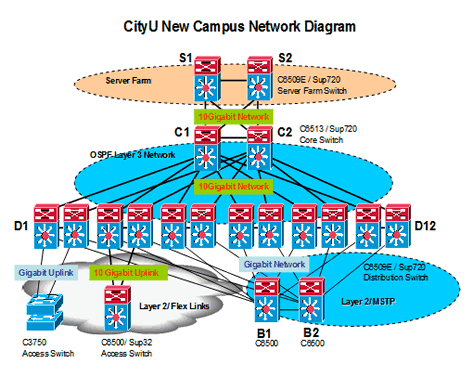Network Upgrade: Campus Network Gets a Boost
Staff members and students may or may not be aware that the University’s data network is currently undergoing a major upgrade process. The upgrade consists of two phases. The first phase was actually started early this year and it has almost come to completion. The second phase will take place near the end of this year and expected to finish by mid 2008.
In general, a data network necessitates a major upgrade every four to six years, not only because an aging data network will be costly (in terms of money and labour) to maintain and may become problematic over time, but also because a data network needs to adapt to advancements in networking technologies and standards as well as to provide sufficient capacity to meet the changing user demands.
The previous network upgrade was conducted between 2001 and 2003, during which all the ATM switches and core routers were replaced with Gigabit Ethernet switches. The upgrade was proved to be a very successful one, for the new network was IP multicast enabled and able to transport converged IP traffic carrying data, video and voice concurrently over the same network media with guaranteed quality level for some selected services. It had also shown high performance, availability and reliability. Nevertheless, another network upgrade is still inevitable after all these years due to shortened product lifecycles of the networking devices.
The current network upgrade project was initiated in 2006, based on the view that the majority of the networking devices in use would become obsolete by the end of 2007. Furthermore, the existing networking devices could not support 10G Ethernet (which becomes more affordable and is the mainstream technology deployed at the core of a data network nowadays) without a forklift upgrade. Since upgrading an existing network was a non-trivial task, it was decided to divide the upgrade in two phases. Phase I was to upgrade all the core switches with 10G interconnections as well as the network switches in a few large wiring closets with 10G uplinks. Phase II is to upgrade the network switches in the other wiring closets such that each switch port will be able to support a 10/100/1000 Mbps connection for the end users. A simplified network diagram showing the new network is shown as follows:

The upgrade will put the University’s data network in par with those of the leading universities in the world and users will not have to worry about running out of network bandwidth in the next few years. The new network will offer many new features, such as enhanced QoS (Quality of Service), Flex Link, Scavenger Traffic Control, Native IPv6 support in hardware, Network Virtualization, etc. Staff members and students will benefit from these new features and enjoy the increased scalability, availability and performance of the network.